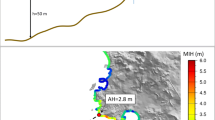Abstract
The best-fit distribution of the tsunami height was investigated along the Eastern Coast of Korean Peninsula. Firstly, the tsunami heights corresponding to the nine probable undersea earthquakes were obtained along the coastline using the numerical simulation. The method of L-moment ratio diagram was used to identify the best-fit probability density function of the tsunami heights caused by each undersea earthquake. The result indicates the generalized Pareto distribution is the best-fit distribution representing the tsunami heights regardless of the characteristics of the undersea earthquakes. This is particularly because the area of high tsunami heights and its relative magnitude to the adjacent locations were similar for the most simulations cases. In addition, this study further investigated the reason why the tsunami height distribution is not represented by the log-normal (LN) distribution as suggested by the previous studies. Result of the investigation indicates that the log-normality of the tsunami heights can be preserved when the length of a coastal line is not long such that the homogeneity of the length of the wave propagation paths reaching at different locations of the coastal line is preserved. This subsequently secures the central limit theorem making the distribution of the tsunami heights have the LN distribution. As the length of the coastal line increases, the deviation of the tsunami height distribution from the log-normality increases.










Similar content being viewed by others
References
Cho Y-S (1995) Numerical simulations of tsunami propagation and run-up. PhD Thesis, Cornell University, USA
Cho Y-S, Yoon SB (1998) A modified leap-frog scheme for linear shallow-water equations. Coast Eng J 40(2):191–205
Cho Y-S, Sohn D-H, Lee S-O (2007) Practical modified scheme of linear shallow-water equations for distant propagation of tsunamis. Ocean Eng 34(11–12):1769–1777
Cho Y-S, Kim YC, Kim D (2013) On the spatial pattern of the distribution of the tsunami run-up heights. Stoch Environ Res Risk Assess 27(6):1333–1346
Choi BH, Woo SB, Pelinovsky E (1994) A numerical simulation of the 1993 East Sea tsunami. J Korean Soc Coast Ocean Eng 6(4):404–412
Choi BH, Pelinovsky E, Ryabov I, Hong SJ (2002) Distribution functions of tsunami wave heights. Nat Hazards 25(1):1–21
Choi BH, Pelinovsky E, Hong SJ, Woo SB (2003) Computation of tsunamis in the East (Japan) Sea using dynamically interfaced nested model. Pure Appl Geophys 160:1383–1414
Choi BH, Hong SJ, Pelinovsky E (2006) Distribution of runup heights of the December 26, 2004 tsunami in the Indian Ocean. Geophys Res Lett 33(L13601):1–4
Choi BH, Min BI, Pelinovsky E, Tsuji Y, Kim KO (2012) Comparable analysis of the distribution functions of runup heights of the 1896, 1933 and 2011 Japanese Tsunamis in the Sanriku Area. Nat Hazards Earth Syst Sci 2012(12):1463–1467
Go ChN (1987) Statistical properties of tsunami runup heights at the coast of Kuril Island and Japan. Institute of Marine Geology and Geophysics, Sakhalin
Go ChN (1997) Statistical distribution of the tsunami heights along the coast. Tsunami and accompanied phenomena. Institute of Marine Geology and Geophysics, Sakhalin, pp 73–79
Ha TM, Cho YS, Choi MK, Jeong WC (2007) Run-up heights of Tsunami along the Eastern Coast of the Korean Peninsula. J Coast Res SI 50:348–352
Hosking JR (1990) L-moments: analysis and estimation of distributions using linear combinations of order statistics. J R Stat Soc B 52:105–124
Imamura F, Shuto N, Goto C (1988) Numerical simulations of the transoceanic propagation of tsunamis. In: Proceedings of 6th Congress Asian and Pacific Regional Division. IAHR, Japan, pp 265–272
Kajiura K (1983) Some statistics related to observed tsunami heights along the coast of Japan. In: Iida K, Iwasaki T (eds) Tsunamis: their science and engineering. Terra Scientific, Tokyo, pp 131–145
Kim YC, Choi M, Cho Y-S (2012) Tsunami hazard area predicted by probability distribution tendency. J Coast Res 28(5):1020–1031
Korean Peninsula Energy Development Organization (1999) Estimation of tsunami height for KEDO LWR Project. Korea Power Engineering Company, Inc., Korea
Liu PL-F, Cho Y-S, Yoon SB, Seo SN (1960) Tsunami: progress in prediction, disaster prevention and warning. In: EI-Sabh MI (ed) Chilean tsunami propagation and inundation at Hilo, Hawaii. Kluwer Academic Publishers, Dordrecht, pp 99–115
Mansinha L, Smylie DE (1971) The displacement fields of inclined faults. Bull Seismol Soc Am 61(5):1433–1440
Mazova R, Pelinovsky E, Poplavsky A (1989) Physical interpretation of tsunami height repeatability law. Vulcanol Seismol 8(1):94–101
Pelinovsky E, Yuliadi D, Prasetya G, Hidayat R (1997a) The 1996 Sulawesi tsunami. Nat Hazards 16(1):29–38
Pelinovsky E, Yuliadi D, Prasetya G, Hidayat R (1997b) The January 1, 1996 Sulawesi Island tsunami. Int J Tsunami Soc 15(2):107–123
Shin H, Jung Y, Jeong C, Heo J (2012) Assessment of modified Anderson–Darling test statistics for the generalized extreme value and generalized logistic distributions. Stoch Environ Res Risk Assess 26:105–114
Sohn D-H, Ha T, Cho Y-S (2009) Distant tsunami simulation with corrected dispersion effects. Coast Eng J 51(2):123–141
Van Dorn WG (1965) Tsunamis. In: Chow VT (ed) Advances in hydroscience. Elsevier, New York
Yoon SB (2002) Propagation of tsunamis over slowly varying topography. J Geophys Res 107(10):4(1)–4(11)
Yuichiro Tanioka Y, Kususose T, Kathiroli S, Nishimura Y, Iwasaki SI, Satake K (2006) Rupture process of the 2004 great Sumatra–Andaman earthquake estimated from tsunami waveforms. Earth Planets Space 58:203–209
Acknowledgments
The research of Professor Yong-Sik Cho, was supported by the Research Program through the National Research Foundation of Korea funded by the Ministry of Education, Science and Technology (Grant No. 2011-0015386), and the research of Professor Seung-Oh Lee, was supported by the Basic Science Research Program through the National Research Foundation of Korea funded by the Ministry of Education (Grant No. 2011-0015080).
Author information
Authors and Affiliations
Corresponding author
Rights and permissions
About this article
Cite this article
Kim, D., Kim, B.J., Lee, SO. et al. Best-fit distribution and log-normality for tsunami heights along coastal lines. Stoch Environ Res Risk Assess 28, 881–893 (2014). https://doi.org/10.1007/s00477-013-0778-y
Published:
Issue Date:
DOI: https://doi.org/10.1007/s00477-013-0778-y




